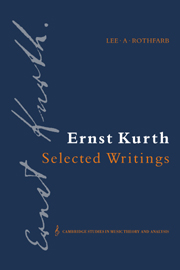Book contents
- Frontmatter
- Contents
- Foreword by Ian Bent
- Preface
- Notes on the translation
- Introduction
- Part I Grundlagen des linearen Kontrapunkts (Foundations of linear counterpoint)
- Part II Romantische Harmonik und ihre Krise in Wagners “Tristan” (Romantic harmony and its crisis in Wagner's “Tristan”)
- Part III Bruckner
- 6 Bruckner's form as undulatory phases
- 7 Details of Bruckner's symphonic waves
- Appendix: Complete tables of contents for Kurth's Grundlagen des linearen Kontrapunkts, Romantische Harmonik und ihre Krise in Wagners “Tristan” and Bruckner
- Select bibliography
- Index of musical examples
- General index
6 - Bruckner's form as undulatory phases
Published online by Cambridge University Press: 10 December 2009
- Frontmatter
- Contents
- Foreword by Ian Bent
- Preface
- Notes on the translation
- Introduction
- Part I Grundlagen des linearen Kontrapunkts (Foundations of linear counterpoint)
- Part II Romantische Harmonik und ihre Krise in Wagners “Tristan” (Romantic harmony and its crisis in Wagner's “Tristan”)
- Part III Bruckner
- 6 Bruckner's form as undulatory phases
- 7 Details of Bruckner's symphonic waves
- Appendix: Complete tables of contents for Kurth's Grundlagen des linearen Kontrapunkts, Romantische Harmonik und ihre Krise in Wagners “Tristan” and Bruckner
- Select bibliography
- Index of musical examples
- General index
Summary
The translations in chapters 6 and 7 of this reader are from Bruckner, vol. I, part 2 (“The dynamics of form”), chapter 2 (“The Symphonic Wave”). Part 1 provides the cultural background for the composer's work, and includes a psychoanalytically oriented biography. For Kurth, Bruckner was a mystic, whose personal and creative tensions combined to produce a music shaped by dynamic processes. These Kurth expounds theoretically in part 2, chapter 1 (“Bruckner's formal principle”). In the ensuing chapters he then illustrates analytically various facets of the process, starting in chapter 2 with some basic traits of “wave dynamics” (Wellendynamik), such as wave initiation and dissipation; reverberatory waves; the illusion of symphonic “space”; dynamically determined motivic transformations; and the organicism in wave structure. Most of the musical examples are relatively brief, the longest being the openings of the first and last movements of the Sixth Symphony. Kurth discusses these longer passages in short segments, the goal being to show how Bruckner hierarchically builds the overriding continuity and dynamic logic from short segments.
Readers should keep in mind that some of Kurth's analytical commentary depends on first-edition scores that are now considered obsolete. Analytical statements that rely on unauthentic orchestration, registration, dynamics, and phrasing, for example, may not hold up in light of modern editions of the symphonies. Although certain of Kurth's analytical statements may no longer be fully supportable, his idea of dynamic form, and the musical criteria employed to illustrate it, are nevertheless significant and remain valid in principle.
- Type
- Chapter
- Information
- Ernst Kurth: Selected Writings , pp. 151 - 187Publisher: Cambridge University PressPrint publication year: 1991



